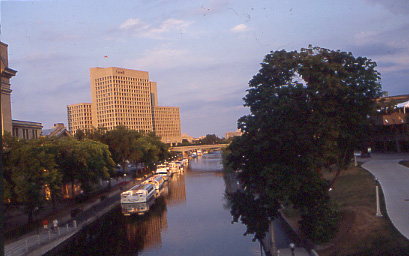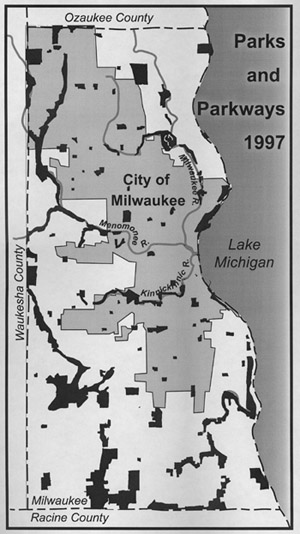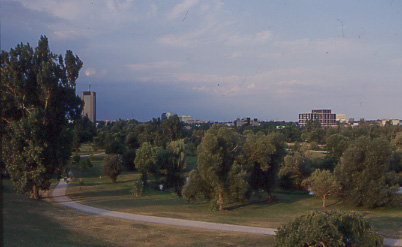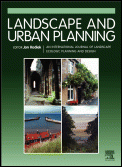|
Featured Research Project (August - October 2002)
The Relationship of Historic City Form and Contemporary Greenway Implementation: A Comparison of Milwaukee, Wisconsin (USA) and Ottawa, Ontario (Canada)
Associate Professor Donna Erickson
Introduction
The greenway idea, a renewed landscape concept from the nineteenth and early twentieth centuries, has swept across North America. Greenways are linear open space corridors that link natural features with each other and with human populations. Some cities have implemented impressive greenway networks. Others continue to develop comprehensive greenway plans, attempting to knit together a variety of urban ecosystems. Meanwhile, urban planners and managers are increasingly expecting connected landscape corridors to provide more than park and recreation functions - i.e. broadening from a target on connected trail systems. They are pr omoting metropolitan greenway networks that help shape urban growth, contribute critical environmental values and, indeed, place economic development and neighborhood revitalization. This research documents how two cities, by virtue of early twentieth century parkway and greenbelt designs combined with twenty-first century greenway visions, are poised for innovative, multi-functional greenway systems. Milwaukee, Wisconsin and Ottawa, Ontario demonstrate a legacy of urban open space protection. These are modest, second tier, mid-size cities; both have roots in a blue-collar industrial past. Milwaukee, the largest city in Wisconsin but lacking the state government seat, is twentieth in a size ranking of U.S. Ottawa's roots in lumbering and other resource extraction contrasts with its status as the national capital. It symbolizes a nation's identity and draws tourists from across the continent. These metropolitan areas have achieved well-connected networks of urban and suburban greenways. However, Milwaukee and Ottawa are not well known for progressive, contemporary greenway planning efforts, even though they were strongly influenced by planners' early visions of parkways and greenbelts. omoting metropolitan greenway networks that help shape urban growth, contribute critical environmental values and, indeed, place economic development and neighborhood revitalization. This research documents how two cities, by virtue of early twentieth century parkway and greenbelt designs combined with twenty-first century greenway visions, are poised for innovative, multi-functional greenway systems. Milwaukee, Wisconsin and Ottawa, Ontario demonstrate a legacy of urban open space protection. These are modest, second tier, mid-size cities; both have roots in a blue-collar industrial past. Milwaukee, the largest city in Wisconsin but lacking the state government seat, is twentieth in a size ranking of U.S. Ottawa's roots in lumbering and other resource extraction contrasts with its status as the national capital. It symbolizes a nation's identity and draws tourists from across the continent. These metropolitan areas have achieved well-connected networks of urban and suburban greenways. However, Milwaukee and Ottawa are not well known for progressive, contemporary greenway planning efforts, even though they were strongly influenced by planners' early visions of parkways and greenbelts.
Goals and Research Methods
 This research analyzes urban spatial patterns that create a framework for greenway planning. The influence of large-scale, long-term city plans is explored, especially relating to parkway and greenbelt design nearly a century ago. One U.S. city and one Canadian city were selected deliberately in order to begin explicating transnational differences in open space planning and implementation. For both case study sites, two main questions are asked. First, how have early city planning efforts affected the pattern of connected greenway systems currently in place? For this question, the history of open space planning is explored and the physical change in greenway development over time is assessed. Second, how have these physical histories led to the institutional structures currently used to implement connected greenways? Organizational structures, inter-governmental cooperation, leadership, and objectives are compared in order to assess the degree to which regional greenway visions are being developed and pursued in both cities. The project is based on comparative case study research. Qualitative research techniques are used to develop deep cases, including the use of historic documentation, planning reports, key informant interviews, and site visits. This research analyzes urban spatial patterns that create a framework for greenway planning. The influence of large-scale, long-term city plans is explored, especially relating to parkway and greenbelt design nearly a century ago. One U.S. city and one Canadian city were selected deliberately in order to begin explicating transnational differences in open space planning and implementation. For both case study sites, two main questions are asked. First, how have early city planning efforts affected the pattern of connected greenway systems currently in place? For this question, the history of open space planning is explored and the physical change in greenway development over time is assessed. Second, how have these physical histories led to the institutional structures currently used to implement connected greenways? Organizational structures, inter-governmental cooperation, leadership, and objectives are compared in order to assess the degree to which regional greenway visions are being developed and pursued in both cities. The project is based on comparative case study research. Qualitative research techniques are used to develop deep cases, including the use of historic documentation, planning reports, key informant interviews, and site visits.
Findings
 Greenway Institutional Structures. Milwaukee and Ottawa have historic frameworks for outstanding connected greenway networks, anchored by extensive river corridors in both cities. Spectacular greenway segments exist in both regions, especially along parkways. In addition, both cities have agencies and programs in place for which connected open space is important. However, neither Milwaukee nor Ottawa have a coordinated greenways plan in place, a broad vision that could be mapped, nor an agency with the authority to implement it. Greenway Institutional Structures. Milwaukee and Ottawa have historic frameworks for outstanding connected greenway networks, anchored by extensive river corridors in both cities. Spectacular greenway segments exist in both regions, especially along parkways. In addition, both cities have agencies and programs in place for which connected open space is important. However, neither Milwaukee nor Ottawa have a coordinated greenways plan in place, a broad vision that could be mapped, nor an agency with the authority to implement it.
Inter-governmental Cooperation and Leadership. Inter-governmental cooperation will be critical for capitalizing on the strong historic open space precedents in both cities. Milwaukee and Ottawa have similar but different stories in this regard, but collaboration around regional greenways planning is piecemeal overall. The agencies that do care about greenway objectives are collaborating in targeted, opportunistic areas. Furthermore, both Milwaukee and Ottawa suffer from a paucity of influential leaders and advocates for connected greenway systems.
Greenway Objectives. The objectives for developing and protecting greenways change over time. For Milwaukee, protected greenway corridors were originally motivated by recreation and environmental protection, but non-motorized transportation has been an important driver in recent years. In Ottawa, a heavy priority is being placed on stronger ecological protection goals, while focusing on recreation as a key component.
Finally, both Milwaukee and Ottawa seem poised for integrated greenways programs, accelerated by innovative experimental projects, increased environmental awareness, and growing institutional capacity.
 Project Background Project Background
This research project was funded by the Canadian Embassy. The paper was invited for a special issue of Landscape and Urban Planning now in review.
Featured Research Project Archives
Past Featured Research Projects are stored in the Archives.
|


 omoting metropolitan greenway networks that help shape urban growth, contribute critical environmental values and, indeed, place economic development and neighborhood revitalization. This research documents how two cities, by virtue of early twentieth century parkway and greenbelt designs combined with twenty-first century greenway visions, are poised for innovative, multi-functional greenway systems. Milwaukee, Wisconsin and Ottawa, Ontario demonstrate a legacy of urban open space protection. These are modest, second tier, mid-size cities; both have roots in a blue-collar industrial past. Milwaukee, the largest city in Wisconsin but lacking the state government seat, is twentieth in a size ranking of U.S. Ottawa's roots in lumbering and other resource extraction contrasts with its status as the national capital. It symbolizes a nation's identity and draws tourists from across the continent. These metropolitan areas have achieved well-connected networks of urban and suburban greenways. However, Milwaukee and Ottawa are not well known for progressive, contemporary greenway planning efforts, even though they were strongly influenced by planners' early visions of parkways and greenbelts.
omoting metropolitan greenway networks that help shape urban growth, contribute critical environmental values and, indeed, place economic development and neighborhood revitalization. This research documents how two cities, by virtue of early twentieth century parkway and greenbelt designs combined with twenty-first century greenway visions, are poised for innovative, multi-functional greenway systems. Milwaukee, Wisconsin and Ottawa, Ontario demonstrate a legacy of urban open space protection. These are modest, second tier, mid-size cities; both have roots in a blue-collar industrial past. Milwaukee, the largest city in Wisconsin but lacking the state government seat, is twentieth in a size ranking of U.S. Ottawa's roots in lumbering and other resource extraction contrasts with its status as the national capital. It symbolizes a nation's identity and draws tourists from across the continent. These metropolitan areas have achieved well-connected networks of urban and suburban greenways. However, Milwaukee and Ottawa are not well known for progressive, contemporary greenway planning efforts, even though they were strongly influenced by planners' early visions of parkways and greenbelts.
 This research analyzes urban spatial patterns that create a framework for greenway planning. The influence of large-scale, long-term city plans is explored, especially relating to parkway and greenbelt design nearly a century ago. One U.S. city and one Canadian city were selected deliberately in order to begin explicating transnational differences in open space planning and implementation. For both case study sites, two main questions are asked. First, how have early city planning efforts affected the pattern of connected greenway systems currently in place? For this question, the history of open space planning is explored and the physical change in greenway development over time is assessed. Second, how have these physical histories led to the institutional structures currently used to implement connected greenways? Organizational structures, inter-governmental cooperation, leadership, and objectives are compared in order to assess the degree to which regional greenway visions are being developed and pursued in both cities. The project is based on comparative case study research. Qualitative research techniques are used to develop deep cases, including the use of historic documentation, planning reports, key informant interviews, and site visits.
This research analyzes urban spatial patterns that create a framework for greenway planning. The influence of large-scale, long-term city plans is explored, especially relating to parkway and greenbelt design nearly a century ago. One U.S. city and one Canadian city were selected deliberately in order to begin explicating transnational differences in open space planning and implementation. For both case study sites, two main questions are asked. First, how have early city planning efforts affected the pattern of connected greenway systems currently in place? For this question, the history of open space planning is explored and the physical change in greenway development over time is assessed. Second, how have these physical histories led to the institutional structures currently used to implement connected greenways? Organizational structures, inter-governmental cooperation, leadership, and objectives are compared in order to assess the degree to which regional greenway visions are being developed and pursued in both cities. The project is based on comparative case study research. Qualitative research techniques are used to develop deep cases, including the use of historic documentation, planning reports, key informant interviews, and site visits.
 Greenway Institutional Structures. Milwaukee and Ottawa have historic frameworks for outstanding connected greenway networks, anchored by extensive river corridors in both cities. Spectacular greenway segments exist in both regions, especially along parkways. In addition, both cities have agencies and programs in place for which connected open space is important. However, neither Milwaukee nor Ottawa have a coordinated greenways plan in place, a broad vision that could be mapped, nor an agency with the authority to implement it.
Greenway Institutional Structures. Milwaukee and Ottawa have historic frameworks for outstanding connected greenway networks, anchored by extensive river corridors in both cities. Spectacular greenway segments exist in both regions, especially along parkways. In addition, both cities have agencies and programs in place for which connected open space is important. However, neither Milwaukee nor Ottawa have a coordinated greenways plan in place, a broad vision that could be mapped, nor an agency with the authority to implement it. 